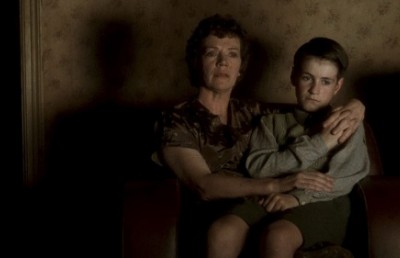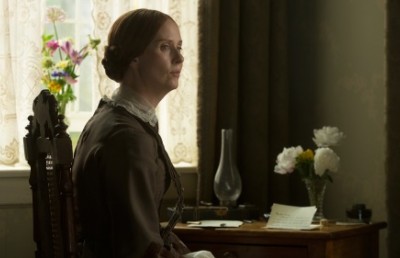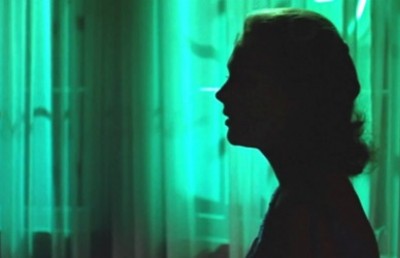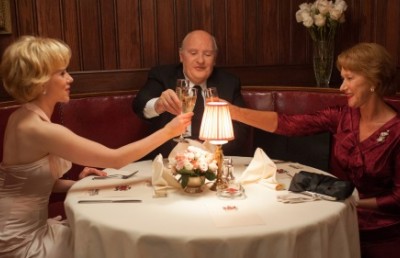Filmic Space and Real Time in Rope
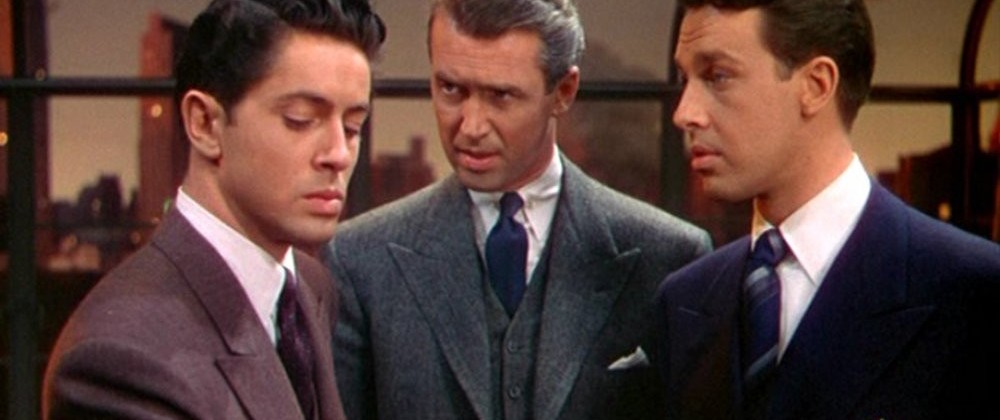
“Brandon, how did you feel?”
“When?”
“During it?”
([Philip Morgan to Brandon Shaw)
With Rope (1948) Hitchcock adapted the 1929 stage play by Patrick Hamilton that is loosely based on the real life murder of a 14-year-old boy by University students Nathan Leopold and Richard Loeb, a murder that was a self-challenge to validate their shared belief that superior human beings are above the law. Hitchcock’s self-imposed technical challenge was to restrict the mise-en-scène to the same real-time structure of the play, using long takes, moving camera, moveable sets and a combination of hidden and unobtrusive edits to seam together the decoupage.
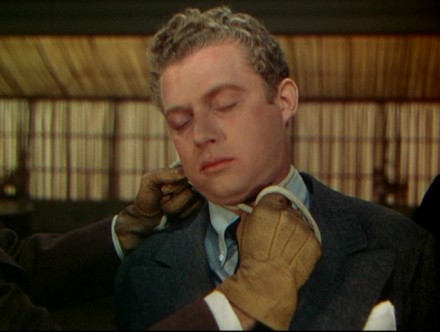
With these parameters in play, Rope explores some of the fundamental characteristics of the cinematic abstraction of time and space by using the mobile camera as an agent that gives plastic reality to subjective material. In Rope, a synthesis of real time and filmic space forces the viewer to absorb narrative information on multiple, often distastefully ironic levels. At the same time, the viewer is given freedom of selection in terms of how, when, and why his/her attention is split, inviting some comparison with similar choices experienced during depth of focus shots, a spatial configuration that Hitchcock characteristically avoided. The movement of the camera throughout the film places the viewer in the ethically, emotionally, and psychologically uncomfortable position of perceiving perversity in the relationship between image and dialogue.
For example, during the party Mrs. Atwater (Constance Collier), David’s aunt, gives an impromptu palm reading to Philip, a concert pianist anticipating a recital at Town Hall arranged for him by his partner in murder Brandon. Philip stands with his hands outstretched, palms facing outward. Over a medium close-up of Philip’s hands Mrs. Atwater gives her prediction: “These hands will bring you great fame.” The camera then pans slowly up to a medium close-up of Philip’s face, as he stares ahead with a mournful, troubled expression. As the camera pans upward, Mr. Kentley, off-screen, refers to the first editions that Brandon has offered to give him: “Well, I consider myself a very fortunate man today.”
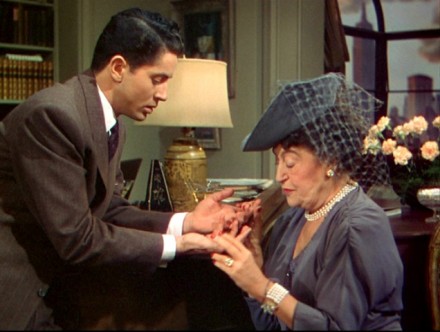
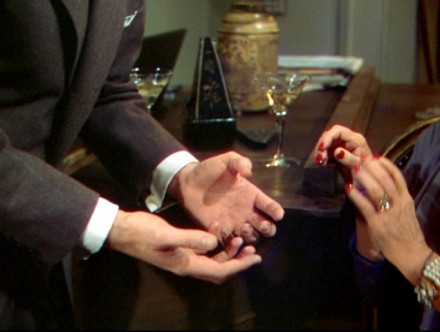
In this example, the homogenous organization of space allows narrative coincidence to provoke the viewer. We are disturbed by the irony of Mrs. Atwater’s speculation about Philip’s future. The viewer knows that the “fame” achieved by Philip’s “artistic” hands will become the public disgrace of being convicted of murder. There is some viewer identification with Philip. Unlike Brandon, he appears to be genuinely distraught over the killing. While Philip’s neurotic submission to the killing is both shallow and repugnant, in that he even lacks Brandon’s ugly pseudo-intellectual justification for the murder, Philip does articulate some of the viewer’s moral indignation when he tells Brandon that it will not be easy to deal with David’s parents or that it is a “human” reaction to feel “weakness,” i.e. regret. The simultaneity of Philip’s sorrowful expression and Mr. Kentley’s statement forces the viewer to make a repellant link between the harmless and the tragic: far from being a “fortunate” occasion for Mr. Kentley, the viewer is aware that he will ultimately discover horror and tragedy in the events of this day. Given the same dialogue and narrative ingredients, classical cutting, say from a close-up of Mrs. Atwater to a close-up of Philip’s hands to a close-up of Philip to a close-up of Mr. Kentley, would certainly undo the delicately woven strands of perception and emotional identification. Robin Wood comments on some of this, using the simpler example of the slow, left to right pan across Mrs. Atwater, Rupert, Mr. Kentley, and Brandon while they are sitting on the sofa and Rupert is delineating his methods for eliminating disagreeable members of the populace such as “bird lovers,” “small children,” “tap dancers,” etc. 1 Rupert suggests that “Cut a throat week” or “Strangulation Day” would be very helpful. Wood is correct in pointing out that Mr. Kentley’s behavior during the pan, i.e. looking out the window with growing concern about his son David’s whereabouts while Rupert speaks with black humor about killing off inferior human obstacles, would have been far more obvious had cuts been used.
Indeed, the slow backtrack from Philip after the palm reading makes Mr. Kentley’s comment about feeling fortunate all the more “incidental” by removing it from the viewer’s immediate attention. The camera continues backtracking while Janet reassures Mr. Kentley that David will “probably be here in a minute,” stopping behind the chest containing David’s body and culminating in a long-shot of the entire living room, as Philip sits at the piano to play and Rupert arrives. The tracking shot takes its place within the film as a whole that, theoretically, functions as a monolithic, unfurling camera movement. As discussed earlier, there is a freedom of selection at work here. During this shot, the viewer almost simultaneously has access to Philip’s hands, Mrs. Atwater’s voice, part of Mrs. Atwater’s body, Philip’s face and expression, Mr. Kentley’s voice, and as the view of the room widens, Mr. Kentley, Janet, Brandon, and finally Rupert when the camera pans slightly to the left to show he’s arrived. Like several of the more complex camera movements in the film, this shot makes the viewer especially sensitive to elements of timing, perception, concurrence, and contrast, elements that are normally taken for granted in conventional cinema.
Another complex camera movement begins after the arrival of Mr. Kentley and Mrs. Atwater. The camera pans from Mrs. Atwater who squints myopically into the living room as she mistakes Kenneth for David. “Oh David!” says Mrs. Atwater as the camera sweeps past Janet and Kenneth, panning quickly over to a medium shot of Philip. During the abrupt pan, there is Brandon’s off-screen correction and the crack of glass. When the camera finishes its movement with a close-up of Philip’s hands, we realize that Mrs. Atwater’s misperception was so unsettling for Philip that he has broken his champagne class and cut himself. Hitchcock did not believe that the camera should be moved for superficial reasons 2 and his most intelligently motivated camera movements are summoned by very carefully chosen narrative information. The same principle is applied in another of Rope’s more elaborate shots: as Mrs. Wilson begins clearing away the food, she discusses the sudden switch in the dining arrangements with Rupert who stands next to her eating his dessert. The camera slowly tracks in on Mrs. Wilson and Rupert, isolating Rupert at one point when he appears more than a little curious after learning about the “mad rush” in the morning that changed into Brandon telling Mrs. Wilson to take “the whole afternoon” for grocery shopping. As Mrs. Wilson continues summarizing to Rupert the last minute shift of books to the dining room and food to the chest, the camera slowly backtracks as their voices become less audible and the music volume increases, making the final part of Mrs. Wilson’s explanation unintelligible. At this point Philip appears at the left of the frame, emerging from off-screen. He is worried by Mrs. Wilson’s obvious demonstration to Rupert that something peculiar happened with the chest. In a close-up shot, Philip turns towards the camera, facing the dining room, and starts to mouth Brandon’s name; composing himself, he walks over to Mrs. Wilson and Rupert and casually points out the convenience of serving dinner in the living room.
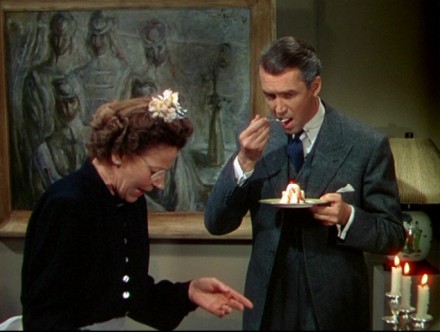
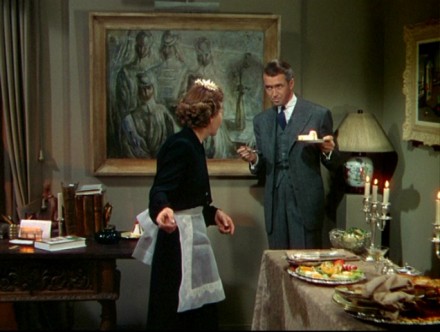
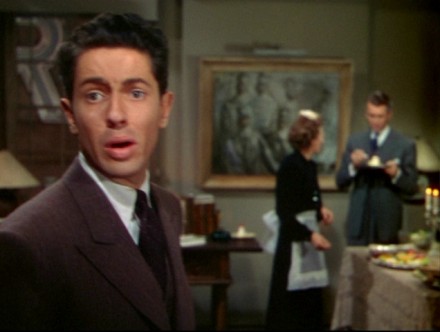
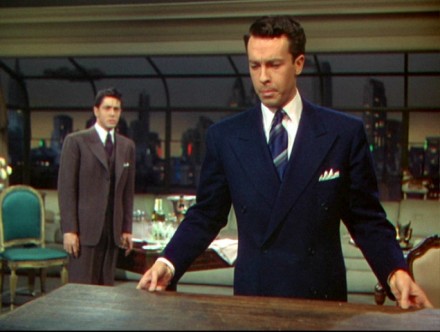
These camera movements connect threads of narrative and psychological material by manipulating elements of off-screen space. The sweeping pan which rushes the viewer across the living room towards Philip makes Brandon’s nervous explanation to Mrs. Atwater that she has mistaken Kenneth for David and the sound of Philip’s glass cracking all the more demonstrative precisely because these aural components occur off-screen. The viewer is transported from Mrs. Atwater precisely at the moment that she blinks and smiles, believing that David is in the room. Mrs. Atwater’s error, in a sense, is a catalyst that propels the camera; the energized pan across the room suppresses viewer awareness of Brandon’s hasty rectification and the breaking glass before it connects the unexpected confusion about David to Philip. It is only when the camera tracks into a close-up of Philip’s bloodied hands that we realize how the energy of the camera movement has expressed the deep-seated turmoil that is in Philip.
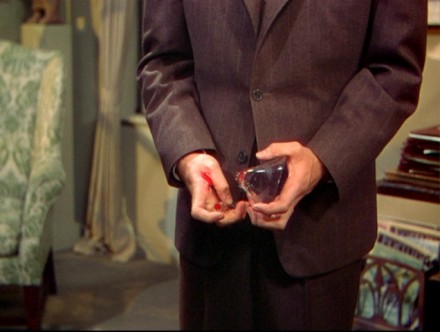
The slow, forward tracking shot that isolates Mrs. Wilson and Rupert functions similarly. As Mrs. Wilson continues to explain the oddities of the day, Rupert becomes more suspicious. When the camera withdraws, Hitchcock makes the dialogue less audible and raises the volume of the music. When Philip suddenly enters the frame, the viewer can no longer follow what is being said but knows what the conversation has been about. Thus, Philip’s anxiety as Mrs. Wilson continues gesturing towards the chest is highlighted not only because he is emphasized in medium close-up as he’s about to call Brandon but especially because the viewer already knows all of the details being discussed, details that will lead Rupert to the truth. For Philip there is simply fear that Mrs. Wilson is merely pointing to the chest; for the viewer, there is a laundry list of inconsistencies in Brandon’s and Philip’s behavior earlier that day, dutifully pointed out by Mrs. Wilson. That Philip should pop into the frame at this point, reminding the viewer of off-screen dimensions of significance, is very effective: Philip comes upon something frightening by chance; the viewer cannot anticipate who will appear within the frame because of the moving camera. The viewer has learned specific things that Philip does not know; the tracking shot makes us privy to Mrs. Wilson’s and Rupert’s conversation. The reverse tracking shot takes the viewer out of the field of perception by manipulating distance and aural levels; Philip experiences the end result of this process while the viewer has confidential knowledge.

The remaining camera movements that create some dramatic or psychological intricacy are a) as the camera pans to the left in a medium long-shot of Mrs. Wilson entering and exiting the living room as she finishes cleaning and gets closer and closer to opening the chest; Rupert is at the extreme right of the frame and everyone is discussing David’s possible whereabouts, b) after Mrs. Atwater speaks to Mrs. Kentley, informing Mr. Kentley how upset his wife is and that she wants him to contact the police: the camera curves past Mrs. Atwater, Janet, and Kenneth, isolating first Brandon, then Philip extremely agitated, and finally Rupert looking on with fearful apprehension, c) as the doorbell rings when Rupert comes back and the camera pans away from Brandon to the door: Brandon’s hand enters the frame from the left and there is a close-up of his revolver as he checks the chamber, and d) the series of camera movements that illustrate Rupert’s hypothetical account of what may have happened if Brandon and Philip had wanted to “kidnap” David.
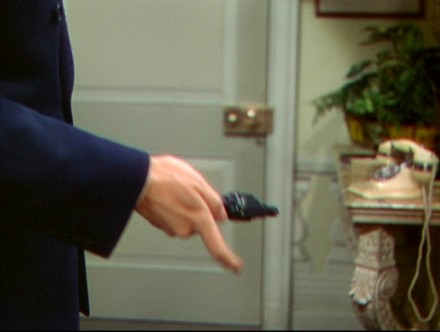
The shot in which Brandon’s hand suddenly appears within the frame with the gun is another example of the economy of suggestion through synecdoche and off-screen space. “Brandon, it’s not loaded, is it?!” asks Philip nervously as Brandon flips the barrel to reveal all six bullets in place. The ring of the doorbell announcing Rupert’s presence, Brandon’s hand holding the gun, Philip’s off-screen panic: in the several seconds that these confluent elements are grouped together, the viewer is given a psychological composite of Brandon’s potentially lethal defense of his actions and Rupert’s attempt to find out the truth. Again we see that cutting from close-ups of the door to the gun to Philip would destroy the visual and emotional complexity.
When Rupert suggests what may have occurred, given his speculation that Brandon and Philip could have kidnapped David, the camera responds to Rupert’s narrative by covering the areas that he describes. The camera moves across the top of the armchair when Rupert assumes that it would have been necessary to knock David unconscious; it goes into the foyer when Rupert indicates how David would have been greeted and that his hat would be taken; it pans across the liquor bottles as Rupert suggests that David would have been offered a drink; it tracks in on the piano when Rupert surmises that Philip would play; it moves across the room towards the chest when Rupert ponders the best place to hide David, etc. Here we have a more simplistic version of a category of camera movement that Hitchcock uses frequently. The camera will demonstrate the particulars of a group of related elements or it will characterize the nature of a given situation: the pan across all of the photographer’s cameras at the beginning of Notorious; the camera movements that note the newspaper with the hidden $40,000 and Norman’s (Anthony Perkins) house in Psycho after Marion (Janet Leigh) is killed; the encircling of the courtyard and Scottie’s (James Stewart) apartment at the beginning of Rear Window. Throughout these examples and many others, Hitchcock gives the camera a kind of independence: he was sensitive to the fact that a moving camera will automatically call attention to itself, therefore he is careful to make very self-contained, economical statements that encapsulate, inquire, or explore. The camera will never make idle observations; everything it shows is connected to some critical element of the narrative. During these types of camera movements in Hitchcock’s work, there is also the sense of an authorial commentary.
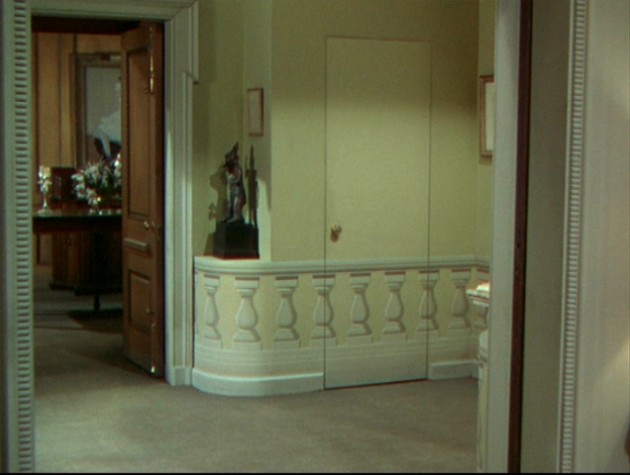
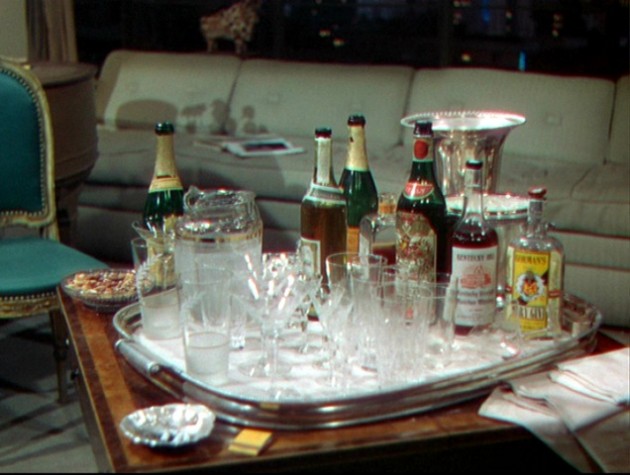
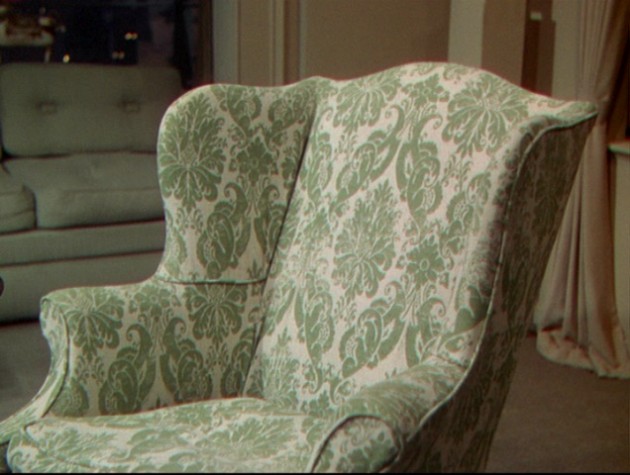
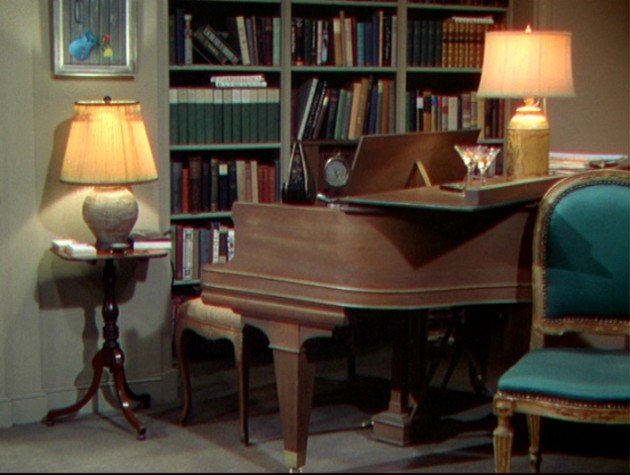
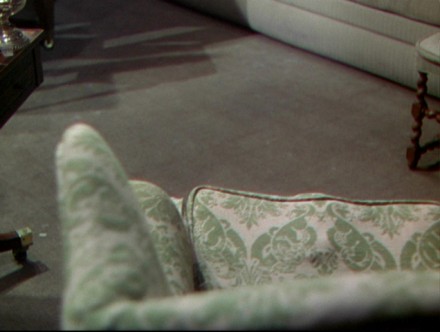
One may note that the pan that begins with Mrs. Atwater’s admonition to Mr. Kentley that he must call the police, which then encompasses all of the characters, has its counterpart in the pan discussed above, where Mrs. Atwater thinks that Kenneth is David. In the first example there is Mrs. Atwater’s obvious pleasure in thinking that David is there; this positive emotion animates the pan. In the second example, Mrs. Atwater has just gotten off the phone with Mrs. Kentley who is now hysterical that no one has heard from her son; the pan again uses Mrs. Atwater to initiate its movement but here its thrust is panic and the decision to contact the authorities. In both instances the camera also canvasses the assembled characters, in this case highlighting their critical observation that something must be seriously wrong by isolating Brandon, Philip, and Rupert, each of whom has disturbed expressions.
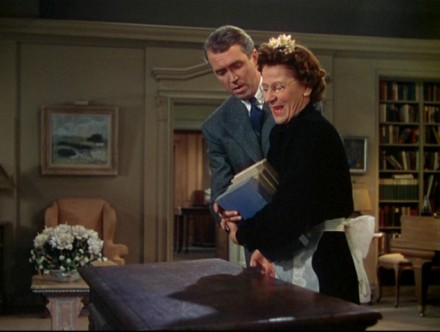
The pan from all of the characters except Mrs. Atwater, who is speaking to Mrs. Kentley in the bedroom, isolates Rupert at the right edge of the frame and Mrs. Wilson who makes several trips from the chest to the kitchen as she clears everything away. The camera holds a stationary long-shot from the chest, showing the remainder of the living room, the dining room, and the kitchen. The viewer’s attention is pointedly divided by this cleverly arranged restriction of information: as the characters discuss David’s prior actions and wonder about his possible present whereabouts, only Rupert is visible, virtually cut in half by the right of the frame. It is Rupert who leads the inquiry about David, particularly in his probing questions to Brandon and Philip. None of the characters, including Rupert, is paying any attention to Mrs. Wilson who, as she brings the last of the books from the dining room, is clearly about to open the chest. She starts to lift it and Rupert offers to help her as Brandon suddenly enters the frame to explain that Mrs. Wilson must come back in the morning to replace the books. Here the counterpoint between the assembled characters discussing David, who remain off-screen, and Mrs. Wilson, gradually moving towards the opening of the chest, is a very articulate demonstration of the ambivalence experienced by the viewer. With Rupert’s position within the frame serving as a kind of bridge between Mrs. Wilson and the other characters, especially given that Brandon’s and Philip’s answers to Rupert’s questions are so flimsy and self-conscious, the viewer becomes sensitized to the multiple possibilities that the visual suspense suggests. There is the possibility that Mrs. Wilson will finally open the chest; that Philip will break down; that Brandon might not notice what Mrs. Wilson is about to do; that Mrs. Wilson might stop her duties just short of putting the books back; that Rupert might turn around to help Mrs. Wilson. The on-screen/off-screen dynamics of the long-shot make viewer identification multidimensional and emotionally disruptive.
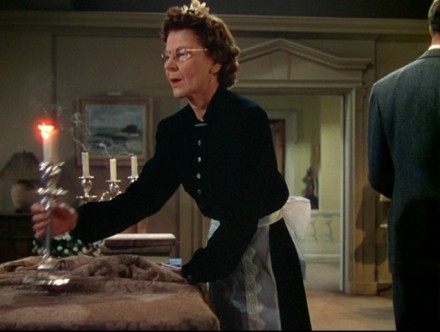
On a more pedestrian level, this methodology also operates throughout the dialogue even when there is no interplay between on-screen and off-screen material. For example, when Kenneth expresses surprise that Brandon is serving champagne, he asks “It isn’t someone’s birthday, is it?” Brandon glibly replies “It’s really almost the opposite.” Later Brandon tells Kenneth, speaking of Janet, “I have the oddest feeling anyway that your chances with the young lady are much better than you think,” referring to Janet’s supposed interest in David. When Brandon suggests that Kenneth bring a glass of champagne to Janet who is phoning Mrs. Kentley in the bedroom, Kenneth jokes: “Then you’d like David to come in!” to which Brandon replies “No, that would be too much of a shock.” Kenneth asks Philip when he arrives “Been up to much lately?” Philip answers “Nothing to speak of,” adding later “I’m to be ‘locked up,’” i.e. that he will be shut away to practice for his recital. Rupert comments on Janet who is clearly upset by Brandon’s machinations: “She seems to be missing David,” to which Brandon woodenly replies “Aren’t…we…all.” In a medium close-up of Janet and Kenneth, with the candelabra atop the chest in the foreground, Janet asks anxiously “Oh, where’s David?!” As Mr. Kentley leaves, Brandon tells him “Would you call me as soon as you hear from David?” and so on. While the double-entendre is not a particularly sophisticated formal device, these examples do suggest that Hitchcock wanted the viewer to experience some unpleasantness as a result of his/her knowledge of the crime. This deception grows progressively darker while at the same time it is the viewer and the viewer alone, until the film’s conclusion, which possesses knowledge of the murder. 3
There are, as this analysis of the film’s more inventive camera movements indicates, some high marks in Rope’s metaphysics. What is unrealized and technically self-conscious in Rope must be measured against those insights the film does provide regarding what cinema can do when one of its innate expressive capabilities (camera movement) is pushed to conceptual extremes. Unfortunately, this symbiosis of filmic space and real time, while it does yield some expressive results, also contains serious problems. The structure of Rope was based upon Hitchcock’s belief that the element of real time was the central component of both play and screen-play. Hitchcock devised this highly unusual treatment of sutured camera movements in order to address the key issue of duration in what he believed to be the most inventive and intelligent way. 4 Herein lies the problem with Rope. While the film is flawed, it does manipulate the interstices between time, space, and narrative in interesting ways. However, it is doubtful that the apparent absence of cuts achieves what was certainly Hitchcock’s primary goal: the continuity of real time. By eschewing the element of compression associated with traditional cutting, Rope purports to be “one” camera movement (except for five masked or direct cuts) because its shape is dictated by temporal, not dramatic, logic. The problem is that the camera movements sometimes confirm and sometimes question the element of real time. The mechanism for this imaginary continuity is faulty: the five points at which dissolves occur unfortunately call excessive attention to the very artificiality that Rope attempts to avoid. Hitchcock found a way to “hide” these dissolves by using a character’s back as a moving diversion. Unfortunately the necessity of repeating this device whereby the screen is momentarily blacked out only reinforces the viewer’s awareness of the technical transition. There are fluctuations in the volume of the soundtrack: the line spoken by the character that functions as camouflage for the lens (usually Brandon) is sometimes noticeably softer or louder than the next line that is presumably uttered seconds later. The animation of the performers’ body language is also inconsistent. With the next take coming hours if not days later, the actors’ gestures and mannerisms could not possibly remain consistent with what was previously photographed. These cosmetic faults, given the extremity of effect that Hitchcock aimed for, damage the temporal purity of the film. This purity is suggested rather than manifested, making this concept of Rope intriguing but problematic.
Montage has shown that real time is just one of many factors that can be manipulated through the nature and number of individual shots edited in a given sequence. From the Odessa steps massacre in Sergei Eisenstein’s Battleship Potemkin (1925) to the cornfield execution in Martin Scorsese’s Casino (1995), montage has shown that dozens if not hundreds of shots can convey only several minutes of screen time and either expand or contract the real time of the event being presented. In fact, it is a rule of cinematic logic that the more shots used in montage, the less “realistic” is the viewer’s perception and appraisal of time. The difficulty with the moving camera as employed by Hitchcock in Rope is that, by eliminating subjectivity in viewer awareness of time, the film places extraordinary weight on the integrity of the image. This results in clever complexes and conceits of meaning, but largely the effect is awkward because the viewer sees the strings being pulled, and the spatial illusion of continuous time fails.
Rope’s emphasis on form, based on strategies of opposition and tension, maximizes the expressive mobility of the camera, a mobility that is not only unconventional but also unnatural: the illusion of temporal continuity is not satisfactorily maintained. At the outset of the film, privileged information is imparted to the viewer who is then abused by the many ways in which the movement of the camera inflicts moral damage upon that very privilege. Thus, the psychological material of the viewer’s point of view becomes synonymous with the spatial exploration and continuousness. That is the key accomplishment of Rope, in spite of many failings. While Rope is certainly not Hitchcock’s most conceptually sophisticated film, it is his most relentless work, using an elaborate (although strained) visual idea to frustrate the viewer’s need for emotional release.
One aspect of Hitchcock’s thinking about how to shoot Rope was technical only. 5 He wanted to meet this self-imposed challenge in a novel way, to create a visual style that emerged from the psychological material of the action. Like the glass floor he used in The Lodger to invoke the insidiousness of the suspicious border’s unheard, pacing footsteps or the wrenching transition caused by the aural bridge between the cleaning lady’s scream and the whistle of Hannay’s escape train in The 39 Steps, Hitchcock envisioned that Rope, although somewhat disparagingly referred to by him years later, 6 would attain a certain level of aesthetic and conceptual sophistication.
In many ways, the character Rupert Cadell represents the viewer. It is Rupert who speaks of murder with a sense of smug superiority; who seems to enjoy the idea of disposing of inferiors from a safe, ideological distance; and who, after realizing that Brandon has used this point of view to murder a human being, becomes outraged that an academic position has been transformed into an excuse for a senseless killing. The viewer, through Rupert’s reactions, is forced, in a sense, to make some kind of moral reparation for his/her amusements. The series of ironies and instances of black comedy resulting from the viewer’s privileged knowledge of David’s murder and the whereabouts of his body make both the viewer and Rupert a participant in something ugly.
Apart from the opening pan, the content of the film is restricted to Brandon’s apartment during the dinner party he and Philip have arranged to “celebrate” the implementation of their ideology. The guests include Mr. Kentley and David’s intended fiancée Janet Walker, as well as their former schoolmaster, Rupert Cadell. The two murderers, especially Brandon, revere Cadell, whose theories of moral and intellectual superiority strengthen their belief that they have the right to “(do) what you and I have talked,” as Brandon explains to Rupert near the conclusion of the film. Rupert knows Brandon and Philip, as well as David and Kenneth, with some degree of adult insight: having taught all of them during their early teens at boarding school, he is very familiar with their personalities and habits. In fact, the play implied a homosexual liaison between Rupert and Brandon that was completely avoided in the screen-play; something that was more readily accepted as part of the British social context of the headmaster-pupil relationship at the time of the play. Rupert knows, for example, that Brandon tends to stammer when he is excited; that Brandon’s favorite bedtime story involved a chest that inadvertently became a coffin for an unsuspecting victim; that Philip lied about not strangling any chickens. He suspects that something is amiss and ultimately discovers the truth, revealing that his disdain for so-called inferior beings was always a facetious, academic posture that toyed with the inconsistencies of language and ideas but could never sanction the murder of another human being. As Brandon introduces Rupert to the guests, we realize that Rupert likes to call rituals of social decorum into question. When Janet wonders if Brandon has done her justice in his comments, Rupert asks “Do you deserve justice?” Reminded by Mr. Kentley that he also “taught” David, apparently a substandard student, Rupert replies “You flatter me.” Told by Kenneth that it is good to see him again, Rupert demands “Why?” but immediately adds “Don’t mind me” when he sees that he has made Kenneth feel awkward. Rupert merely questions the ready-made conventions of society; unlike Brandon, he does not despise his fellow man.
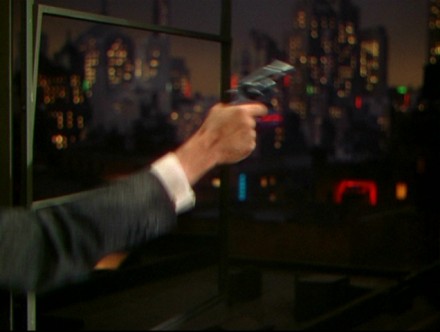
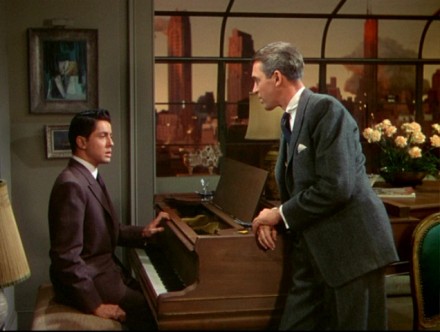
Rupert summons the police by firing shots out an opened window, thus disrupting Hitchcock’s most insulated soundtrack [James Stewart commented on the difficulties during shooting and the necessity of post-synchronization: “We had a lot of rehearsal, but the noise of the moving walls was a problem, and so we had to do the whole thing over again for sound, with just microphones, like a radio play. The dialogue track was then added later.” The Dark Side of Genius: The Life of Alfred Hitchcock, Donald Spoto (Ballantine Books: New York, 1984): pg. 324.]] by introducing natural sounds for only the second time in the film. There is some nominal traffic noise after Brandon opens the curtains, but it is very low and lasts only a few moments. The first time we hear distinct street sounds is while Philip plays the piano and is questioned by Rupert. When Rupert asks him “What’s going on?” there is a siren, perhaps a hidden portent, and Philip looks up at the window for a moment, indicating that he hears it.
While Brandon and Philip shuffle about the room in disbelief, neighbors and passers-by quickly comment upon and identify the origin of the shots, combining with the emergence of a police siren. “Society,” as Rupert points out, will be outraged by this act and a democratic, egalitarian justice will take its course. Against the contemporary background of the Nuremburg trials, the larger implication is clear: Nazism is defeated and will not be tolerated in the free world. The perpetrators of mass genocide will pay the ultimate price for crimes against humanity. “You’re going to die, Brandon! Both of you!” exclaims Rupert as he promises to help the legal system prosecute Brandon and Philip. Rupert does not subscribe to an effete, intellectual elitism that disengages the individual from meaningful interaction with the community, although at first this seems to be the case. Rupert in fact demonstrates that the individual must take responsibility for what happens in society as a whole, something that is diametrically opposed to Brandon’s point of view.
Therefore, if Rupert can be said to represent the viewer, his function in the film is two-fold. On the one hand, his sense of moral outrage articulates the point of view of the viewer from the civilized world who finds the crime reprehensible. On the other hand, with remarks like “Strangulation Day” and so on, Rupert becomes “implicated,” just as the viewer is implicated, in the crime. Finding some of Brandon’s remarks funny; knowing that David’s body is in the chest; sometimes enjoying the (often obtrusive) irony of the proceedings: all of this makes the viewer, with Rupert as his/her proxy, a kind of moral scapegoat.
As in much of Hitchcock’s work, Rope depends upon the unique relationship between style and theme. Apparently Hitchcock was intrigued by a conceit based on the Rope –like convoluted camera movements and the destined fate of his protagonists as the real time clock winds down to their unmasking. 7 Hitchcock spoke of an unrealized project that would have been a documentary on food during a typical twenty-four hour period. 8 It is clear from this unmade film that Hitchcock was fascinated by the enclosure of a temporal system and the logical, visually enunciated progression of details and information. As in some of the superior examples of avant-garde filmmaking from the 60s and 70s, especially the films of Michael Snow, one sees that with Rope and this jettisoned documentary, Hitchcock was very much aware of how formal constructs could be used to turn a film into a structural event based on a single theme or idea.
The moving camera allows Rope to impose a certain kind of functional presentation. The camera numerously adjusts its viewpoint because of the unchecked mobility, a mobility that does not distinguish between functional necessity and expressive emphasis. For example, when Brandon and Philip move from the living room to the dining room to the kitchen during their initial peregrinations within the apartment in preparation for the party after the murder and the concealment of the body at the beginning of the film, the camera must follow them in order for the spatial-temporal continuity of the narrative to be maintained. This logic of display is characteristic of the film as a whole. The camera records characters’ movements and most changes in grouping, such as when guests arrive or when Janet asks Brandon to step into the foyer to express her annoyance at his having invited her ex-boyfriend, Kenneth. While it is problematic and flawed, Rope’s uniqueness lies in its refutation of cinematic compression: Rope has no filmic time. Unlike most films, Rope does not offer diverse, successive or concomitant happenings that occur in compressed, subjective time. Without editing, the moment-by-moment quality of Rope’s temporal verisimilitude becomes a prerequisite for a narrative presented as it happens. The technical inadequacies discussed above lessen the effectiveness of this verisimilitude and diffuse some of its impact.
Rope is based upon the explorative examinations of a moving camera. Given this method, as in the case of the palm reading camera movement, there was some potential for complexity and subtlety. When a shot obeys the functional laws of simple exposition, such as the many pans and tracking shots which follow characters’ behavior and actions, there is no “expressive” articulation. Hitchcock relies on the consistency of this visual-rhythmic system to then introduce spatial motifs that communicate significance as if by chance or as though they functioned as a by-product of the condition of camera mobility that governs the film. The palm-reading example discussed above is an illustration of this idea. The incidental relationship between Mr. Kentley’s off-screen remark about feeling fortunate and Philip’s on-screen expression of remorse could not have been possible if the moving camera was not an omnipresent factor. In some ways this reflects Hitchcock’s life-long preoccupation with the original principles of cinema: early viewers’ fascination with narrative, time, and the frame; the undoing of natural expectations through the inherently illusionary character of the medium; the belief that technical functions of cinema (camera movement) can influence ideas. Unfortunately, Rope reaches its potential in just a handful of shots.
Notes
- “We listen to the clever talk of Rupert and his ex-pupil Brandon about the right of the “superior being” to place himself above accepted morality, even to kill. It is all light-hearted, on Rupert’s side at least, his manner relaxed and engaging; we respond to his charm and to the outrageousness—the freedom and irresponsibility—of his joking. But underlying this amused response we are never allowed to forget what this philosophy, adopted as a code of life, has led to. The camera tracks away from Rupert and Brandon to the right, where Cedric Hardwicke sits in growing uneasiness, and, just as the camera takes him in, turns to look out of the window. We know he is looking to see if his beloved and belated son is coming—the son whose murdered body is in the chest in the middle of the room—and the smile freezes on our faces. The effect is achieved not only through the actor’s performance (which is superb) but by means of the camera movement, which links the father’s movement with the other men and at the same time integrates it in the entire situation; a cut there would have made the point much too obvious, and dissipated the emotional effect by losing the continuity of gaze. The camera movement makes us respond simultaneously to two incompatible attitudes whose conflict forces us (whether or not on a conscious level) to evaluate them.” ↩
- Hitchcock on Hitchcock, Ed. Sidney Gottlieb (University of California Press: Berkeley & Los Angeles, 1995): pg. 208. “The motion picture is not an arena for a display of techniques. It is, rather, a method of telling a story in which techniques, beauty, the virtuosity of the camera, everything must be sacrificed or compromised when it gets in the way of the story itself.” ↩
- Gottlieb, pg. 114. “Let ‘em Play God” ‘The audience knows everything from the start, the players know nothing. There is not a single detail to puzzle the audience. No one on the screen knows except the two murderers. The fact that the audience watches actors go blithely through an atmosphere that is loaded with evil makes for real suspense.’ ↩
- “The stage drama was played out in the actual time of the story; the action is continuous from the moment the curtain goes up until it comes down again. I asked myself whether it was technically possible to film it in the same way. The only way to achieve that, I found, would be to handle the shooting in the same continuous action, with no break in the telling of a story that began at seven-thirty and ends at nine-fifteen.” Hitchcock/ Truffaut, Revised Edition (Simon & Schuster, Inc.: New York, 1985): pg. 179. ↩
- Gottlieb, “My Most Exciting Picture,” pgs. 275-284. ↩
- Hitchcock/Truffaut, pg. 179. “I undertook_Rope_ as a stunt; that’s the only way I can describe it. I really don’t know how I came to indulge in it.” ↩
- “The continuous shooting of Rope, which Hitchcock calls his ‘abandonment of pure cinema’ because it eschewed his normal dependence upon dramatic editing, grows out of both the title image—something continuous that will tie one up—and the main theme of the film—the continuity of word into deed; a murderous human reality is spun out of a musing that was considered safely theoretical.” Alfred Hitchcock Reader, Eds. Marshall Deutelbaum & Leland Poague (Iowa State University Press, Ames, Iowa: 1986): pgs. 21-22. “Hitchcock’s Imagery and Art,” Maurice Yacowar. ↩
- “One unrealized film idea was to show 24 hours in the life of a city, with the frame being the food: how it was imported and prepared and eaten and then at the end of the day thrown away into the sewers.” Wikipedia article on Alfred Hitchcock. ↩



